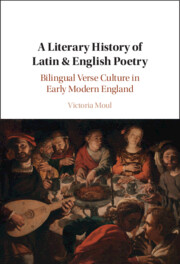Book contents
- A Literary History of Latin & English Poetry
- A Literary History of Latin & English Poetry
- Copyright page
- Dedication
- Contents
- Figures
- Acknowledgements
- Abbreviations
- Introduction
- Part I Shorter Verse
- Chapter 1 Anglo-Latin ‘Moralizing Lyric’ in Early Modern England
- Chapter 2 Metrical Variety and the Development of Latin Lyric Poetry in the Latter Sixteenth Century
- Chapter 3 Buchanan, Beza and the Genre of the Sidney Psalter
- Chapter 4 Formal Panegyric Lyric in England, 1550–1650
- Chapter 5 Abraham Cowley and Formal Innovation
- Chapter 6 Religious and Devotional Epigram and Lyric
- Chapter 7 Epigram Culture and Literary Bilingualism in Early Modern England
- Chapter 8 Satire, Invective and Humorous Verse
- Part II Longer Verse
- Afterword
- Metrical Appendix: Latin Metres
- Bibliography A: Manuscripts
- Bibliography B: Early Printed Books
- Bibliography C: Secondary Literature
- Index
Chapter 8 - Satire, Invective and Humorous Verse
from Part I - Shorter Verse
Published online by Cambridge University Press: 23 June 2022
- A Literary History of Latin & English Poetry
- A Literary History of Latin & English Poetry
- Copyright page
- Dedication
- Contents
- Figures
- Acknowledgements
- Abbreviations
- Introduction
- Part I Shorter Verse
- Chapter 1 Anglo-Latin ‘Moralizing Lyric’ in Early Modern England
- Chapter 2 Metrical Variety and the Development of Latin Lyric Poetry in the Latter Sixteenth Century
- Chapter 3 Buchanan, Beza and the Genre of the Sidney Psalter
- Chapter 4 Formal Panegyric Lyric in England, 1550–1650
- Chapter 5 Abraham Cowley and Formal Innovation
- Chapter 6 Religious and Devotional Epigram and Lyric
- Chapter 7 Epigram Culture and Literary Bilingualism in Early Modern England
- Chapter 8 Satire, Invective and Humorous Verse
- Part II Longer Verse
- Afterword
- Metrical Appendix: Latin Metres
- Bibliography A: Manuscripts
- Bibliography B: Early Printed Books
- Bibliography C: Secondary Literature
- Index
Summary
This chapter deals not with a single form or genre, but with the satiric, invective or humourous use of several. As it happens, the patterns of previous scholarship have proved particularly distorting in relation to Anglo-Latin satiric verse, with neo-Latin scholars tending to focus on Renaissance versions of the classical Roman genre of hexameter satire, typicallyinterpreted in terms of ‘Horatian’ vs ‘Juvenalian’ (less often Persian) style. In England, however, there were almost no examples of this genre of satiric verse until the early eighteenth century. This chapter takes a different approach, attempting to survey the various ways in which Anglo-Latin verse of various genres and formsfunctioned as satire or invective, focusing in particular on satiric epigram, iambic verse, rhyming verse and various kinds of 'free' or experimental poetry. In this way, the chapter offers a guide to the main ways in which Latin verse was used for humourous, satiric and invective purposes in early modern England, with attention to changing patterns over time.
Keywords
- Type
- Chapter
- Information
- A Literary History of Latin & English PoetryBilingual Verse Culture in Early Modern England, pp. 320 - 352Publisher: Cambridge University PressPrint publication year: 2022



